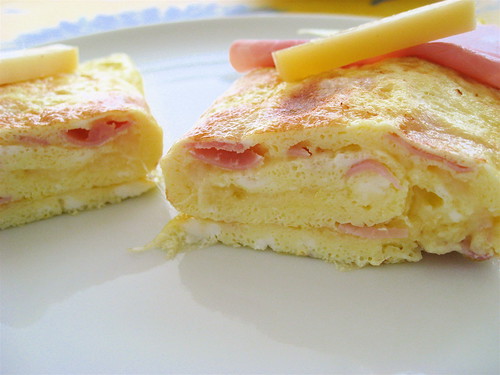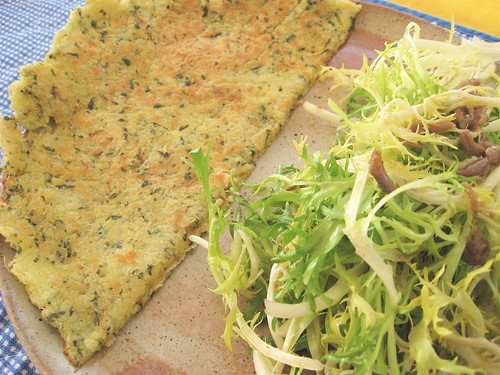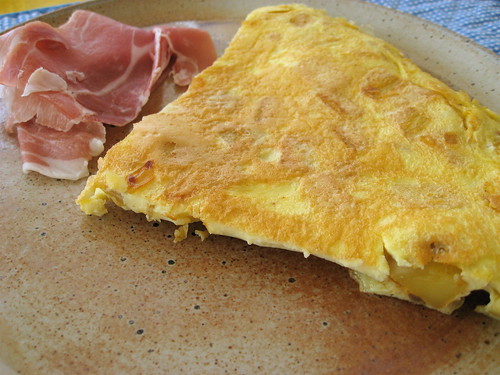
I'm currently in Asia on a well-deserved vacation. More on this trip and, of course, the food when I'm back home.
Friday, November 30, 2007
Eating Hong Kong and Singapore
Posted by
Laurent Martinez
at
11:24 AM
0
comments
![]()
Sunday, November 18, 2007
Tarte au citron

You may not know it, since it has become so ubiquitous in bistrots around the world, but lemon tart is a typical Nicois dish. In Nicois dialect, it is called tourta de limoun and is usually made with lemons from Menton (you remember the place where I had a fantastic lunch at Mirazur? It's there and Mauro Colagreco, by the way, is lucky enough to have in his restaurant backyard a beautiful garden with lemon trees).
Lemons have been cultivated in the region since Ancient times and thrive thanks to the forgiving climate. The fruit is believed to have been imported by the Greeks after they founded the city of Nice around 350 BC.
But let's get back to the recipe. There are many ways to prepare this dessert but Thomas Keller's recipe is in my opinion the best as it produces a particularly light result. In addition, the pine nut crust tastes sweeter and its crumbly texture is less filling than a traditional pate sucree. Instead of Menton lemons that are not available in the US, I adopted a more American approach by using Meyer lemons. Feel free to use local citrus if you can.
Pine nut crust (makes dough for 3 tarts):
2 cups pine nuts
1/3 cup sugar
3 cups flour
8 ounces butter at room temperature
1 large egg
1 tsp vanilla extract
Place the pine nuts in a food processor and pulse until pureed. Add the rest of the ingredients and mix by hand or with a food processor. Divide the dough into 3 equal parts. Keep one and freeze the other two after wrapping them in plastic paper.
Lemon tart (serves 6):
1/3 pine nut crust
2 large eggs
2 large egg yolks
3/4 cups sugar
1/2 cup lemon juice
3 ounces cold butter cut into 6 pieces
Preheat the oven at 350 degrees F. Butter and flour a 9-inch flutted tart pan with a removable bottom (I use a 12-inch but you may prefer a thicker dough). Bake the crust for 20-30 minutes until golden brown.
Prepare the sabayon while the crust is cooling. Mix the eggs, yolks and sugar in a bowl until this mixture is smooth. Set the bowl above a pot of boiling water. Whisk the mixture until thickened. Add 1/3 of the lemon juice. Whisk until thick. Add another 1/3 of lemon juice. Whisk until thick. Add the remaining lemon juice and whisk until thick again.
Turn off the heat and whisk the butter in the sabayon one piece at a time. Pour the sabayon into the crust. Place the pan under the broiler until brown.
Posted by
Laurent Martinez
at
10:39 PM
4
comments
![]()
Tuesday, November 13, 2007
Omelette jambon-fromage

Believe it or not but I was not a great fan of omelettes (or mushrooms by the way) until my mid-twenties (oh yeah, I'm that old!). Hence my frustration as a kid when we would come down from mushroom hunting sessions on Sunday nights which were also the occasion for my parents and their friends to indulge on mushroom omelette. I still feel the same when people around me moan in appreciation while eating oysters, which I've tried repeatedly over the years but cannot come to genuinely enjoy.
However, the rise of Sunday brunch in France over the last decade (and the diversified egg dishes that came with it) as well as the fantastic eggs benedict served in the US, that I discovered 10 years ago during my first stay in Chicago, changed my taste forever. I've become an egg maniac and I like to prepare them multiple ways as you may have noticed over the last 3 posts. The following recipe is directly inspired from the snack section of the fantastic Alain Ducasse's Grand Livre de Cuisine Bistrots, Brasserie et Restaurants de tradition that I've been using intensively over the last couple of years.
It goes without saying that, beyond a little technique (you are supposed to flip the pan to half-roll the omelette on itself), the success of this simple recipe mostly relies on the quality of the ingredients. So don't be cheap, buy the best eggs, cheese and ham you can find. It's worth it.
Ingredients (serves 2)
5 large eggs
80 g (3 oz) grated Comte cheese (gruyere also works fine)
1 large and thick enough slice of boiled ham
1 tbsp olive oil
Salt
Pepper
1. Break the eggs into a mixing bowl and beat them with a fork. Don't overbeat. Add 2 pinches of salt and a little pepper.
2. Cut the slice of ham into 1/2-inch dices and add to the eggs mixture.
3. Heat the oil over medium heat in a non-stick pan. Add the egg mixture. When the center has started coagulating, spread the cheese over the omelette. Make sure to lift the sides of the omelette regularly so it does not stick to the pan.
4. Roll the omelette on itself. Try not to overcook so it remains creamy or even "baveux" if that's the way you like it.
5. Serve as shown on the pictures.
Posted by
Laurent Martinez
at
11:19 PM
4
comments
![]()
Labels: Recipes
Monday, November 12, 2007
Crique ardechoise et frisee

Not sure I have already mentioned this but my mother is from Ardeche, a French departement located on the left bank of the Rhone. It is surrounded by Isere, Gard, Drome (where I was born), Loire, Haute-Loire, Lozere and Vaucluse departements and thus constitutes a sort of frontier that separates North and South of France. It is also a very interesting and varied region especially as far as food is concerned. I used to spend quite a few week ends every year at my grandparents there when I was a kid. Playing among the chestnut trees and discovering the pleasure to eat raspberries and blackberries from the bush were among the activities that kept my cousins and myself busy for whole days.
Criques would be a specialty originating from Ardeche. I say "would" because some attribute the recipe to Provence or Auvergne cooks. No matter where it comes from, this peasant recipe is another illustration of how to turn simple ingredients into a wonderful and satisfying dish.
It is the dish my grandmother used to cook for me every time I would visit her (herbs beignets were also another favorite). It is also that dish, served with frisee, that would greet me more often than not on Saturdays when I came back from school. Needless to say that it holds a particular place in my culinary memories. But before you throw yourself into testing that recipe, a last piece of advice: be generous with garlic and anchovies since they will give a special twist and distinctive Southern French character to the recipe.
Ingredients (serves 2):
Crique:
3 large potatoes
5 garlic cloves
2 tbsp parsley
1 large egg
1 tbsp olive oil
Sea Salt (2 pinches)
Black Pepper
Frisee/vinaigrette:
1 small frisee
5 anchovies
3 tbsp olive oil
1 tbsp jerez vinegar
salt and pepper to taste
1. Peel the potatoes and grate them (I use the thin grid of a hand-grater but you can obviously use a food processor).
2. Mix the grated potatoes with the egg, finely chopped garlic, parsley, salt and pepper. Using a fine sieve, get rid of the excess liquid contained in the mixture. You want to obtain an almost dry blend.
3. Heat the oil in a non-stick pan. Spread the potato mixture in the pan like a pancake and cook on medium heat until slightly brown and crispy on the bottom. Don't forget to lift the crique's sides all along the process so it doesn't stick. Flip and cook on the other side until done.
4. Prepare a vinaigrette mixing olive oil, vinegar, anchovies, salt and pepper. My mother even adds garlic to the mix but as there is already quite a bit of it in the crique, you may not want to have too much of a good thing, right?
5. Blend the frisee and the vinaigrette (use your hands to do so and the result will be even better) just before serving the salad and half of the crique on each plate.
Posted by
Laurent Martinez
at
4:11 PM
2
comments
![]()
Sunday, November 11, 2007
Tortilla de patatas my way

Whether you call it tortilla, omelette or frittata, this egg-dish is ubiquitous across Mediterranean countries and is the staple food for snacks, get-togethers with friends either at home or in a bar. Some like it warm, other prefer to have it cold. I like it both ways. It is also delicious between two slices of baguette in a sandwich.
You can also prepare it with zucchini or mushrooms among many other ingredients. The version presented here is made with potatoes. You may also want to add chorizo or bacon as it will bring a smoky note that goes so well with eggs and potatoes. Since I had neither of them, I replaced chorizo by Pimenton de la Vera, the Spanish take on smoky paprika that gives its characteristic taste and flavor to chorizo.
You may have heard about the French's love for "baveuses" (slimy may be the closest translation) omelettes. However, the following recipe features a more "solid" texture that calls for a little bit more cooking time and eggs beaten slightly longer. I think "baveuse" texture is better suited to plain or cheese/ham omelettes. But ultimately, it's up to you and your taste buds.
This simple dish is the ideal companion of Sundays' brunches. Accompanied by a slice of ham (Prosciutto di San Daniele, Jamon Iberico de Bellota or local) and a glass of good red wine, life doesn't get any better than this.
Ingredients (serves 2-3):
7 large eggs
2 medium potatoes
1 shallot
2 tbsp olive oil
1 tsp Pimenton
1/2 tsp Piment d'Espelette
4 pinches sea salt
1. Peel the potatoes and cut them into 1/2 inch dices.
2. Heat the oil in a non-stick pan. Cook the potatoes on medium heat until almost tender (cover them 5 minutes after starting the process. They should not become brown). Season with 2 pinches of salt. Add the shallots and cook until they are soft and the potatoes fully tender.
3. Crack the eggs open into a mixing bowl. Beat them. Add 2 pinches of salt and the piment d'Espelette.
4. Add the egg mixture to the potatoes and shallots. Cook on medium heat until there is almost no liquid remaining on top and the bottom boasts the nice color shown on the above pictures. During that process, make sure to lift the sides of the omelette with a plastic spatula so it does not stick to the pan. Flip it and cook for 5 more minutes or until done on the other side.
5. Serve with sea salt on top.
Posted by
Laurent Martinez
at
12:00 PM
1 comments
![]()
Labels: Mediterranean, Recipes



